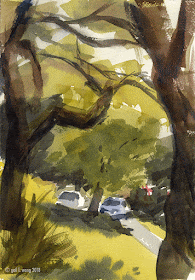The night scene below was a painting done in Tom Hoffman's Tuesday's class. The painting started with the light colors applied on a very wet sheet of watercolor paper. I mean really wet. Holding it under the faucet and wetting both sides of the sheet wet. At this point you get soft edges where colors merge and mix into each other when you apply the paint.
Midtone values and colors were applied over the light colors while everything was still wet. You can tell the paper starts to get a little drier. The paint in the brush is still drier than the wet paper. You are using the wetness of the paper as your water source. Doing that you will avoid blooms.
Finally the darks were put on as the last layer. It was a challenge getting the right consistency and viscosity of paint. You have to get enough pigment in your mix to cover and get it dark enough that it won't dry light. You also need enough fluidity in the paint that you don't lift off the lower layer of paint while painting on the final layer. Areas in this painting where you see the brush strokes are areas where I was pulling off paint while I was applying paint.









